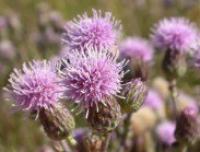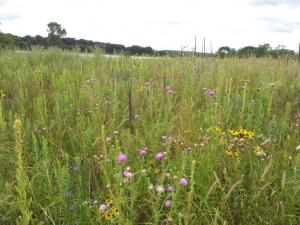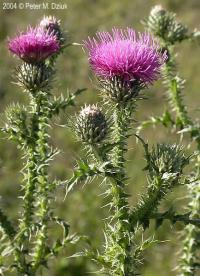Minnesota has many varieties of thistle species, some are native and others are invasive. The three most common invasive thistle species are: Canada thistle, bull thistle, and plumeless thistle. All three are identified by the bright purple flowering head, each with a different inflorescence.
Please remember to read and follow herbicide label instructions. For specific recommendations not covered by the label, contact your distributor or manufacturer representative. Please consult with your local USDA Service Center for a more in-depth look at your site’s specific thistle control strategy.
Prevention
Managing thistle can be difficult. The best plan of action involves having good timing and using the combined methods of mechanical and chemical control to treat the plant before the flowers go to seed. Mature thistle plants can contain up to 10,000 seeds per plant and have an aggressive root system that continually produces new shoots.
Removal Strategies
Thistle spreads quickly to areas that have been disturbed through tillage or have sparse coverage of native grasses or trees.
- Mechanical control will require multiple treatments
- Chemical control can have adverse effects on native forbs
- A combination of mechanical treatment and spot spraying is considered the most effective method of treatment
Clipping
Mechanical treatment will be the most effective in areas where thistle is cohabitating with desired flower species in a native seeding, as spraying will be harmful to many broad-leaved forb species. In this case, clipping multiple times during the growing season to approximately 12" with a mower attachment that does not create windrows will allow for the growth of desired natives while also not allowing thistles to go to seed.
Spraying
Areas that are dense with thistle and not with native flowers can be broadcast sprayed, as the grasses will not be affected by the broad-leaf herbicide. A backpack or handheld sprayer works best for small areas.
Commonly Used Chemicals
- Milestone®: Spring application of 5-7 fl oz/acre through early flower or in the fall (September – light frost). There are many Milestone® resistant forbs that can tolerate application. Do not spray in tree plantings.
- Transline®: Spring application of 1 pint/acre. Controls thistle in tree plantings.
- Curtail®: Spring application of 1.5-3.5 pint/acre




